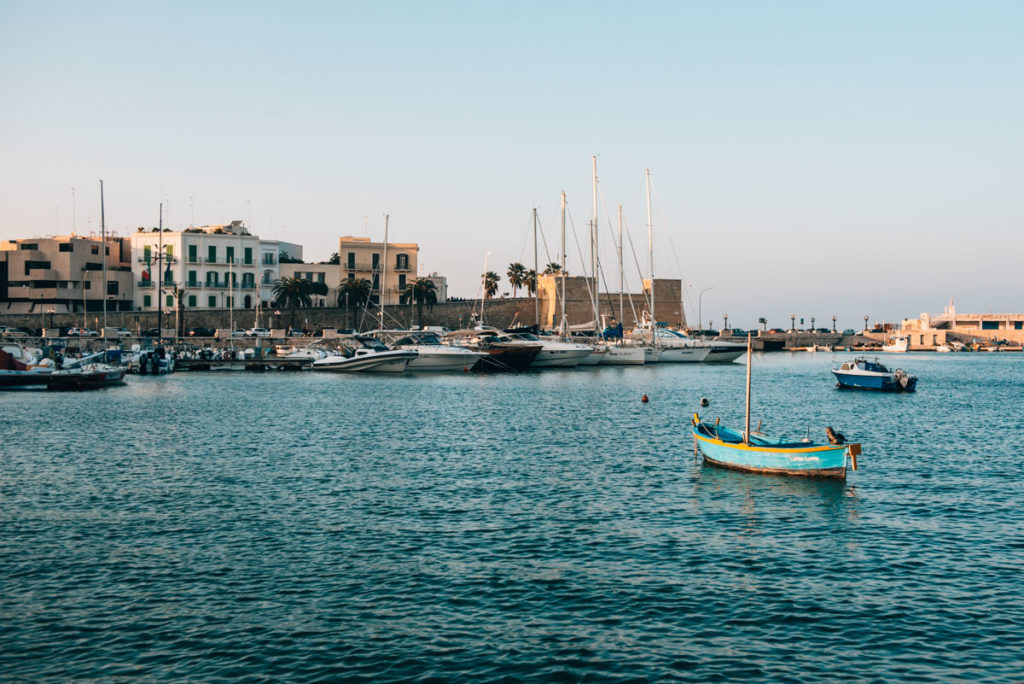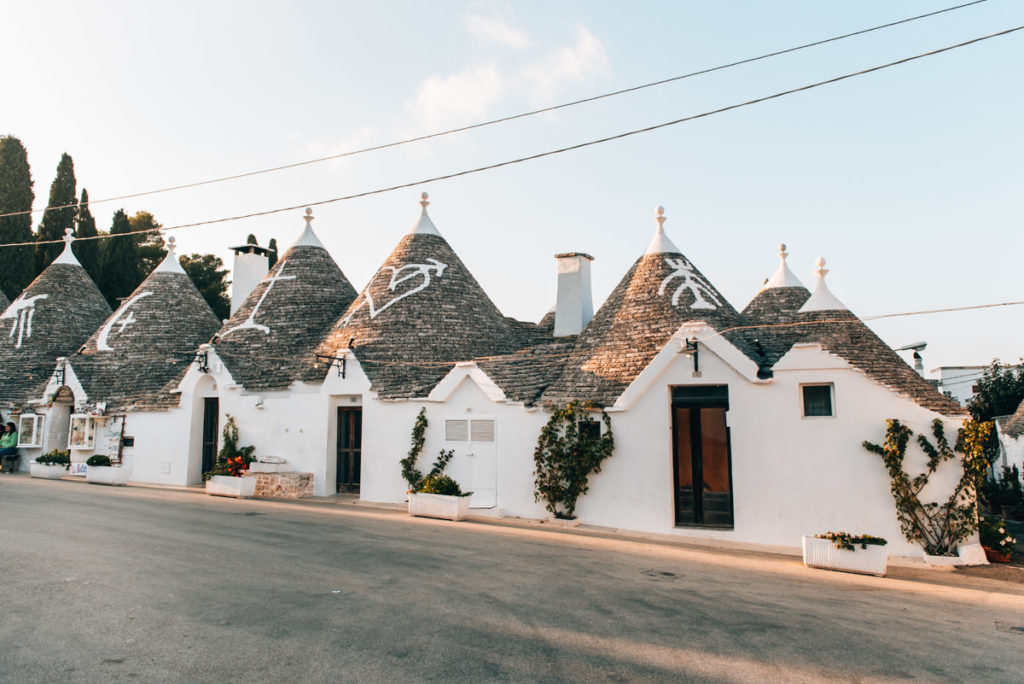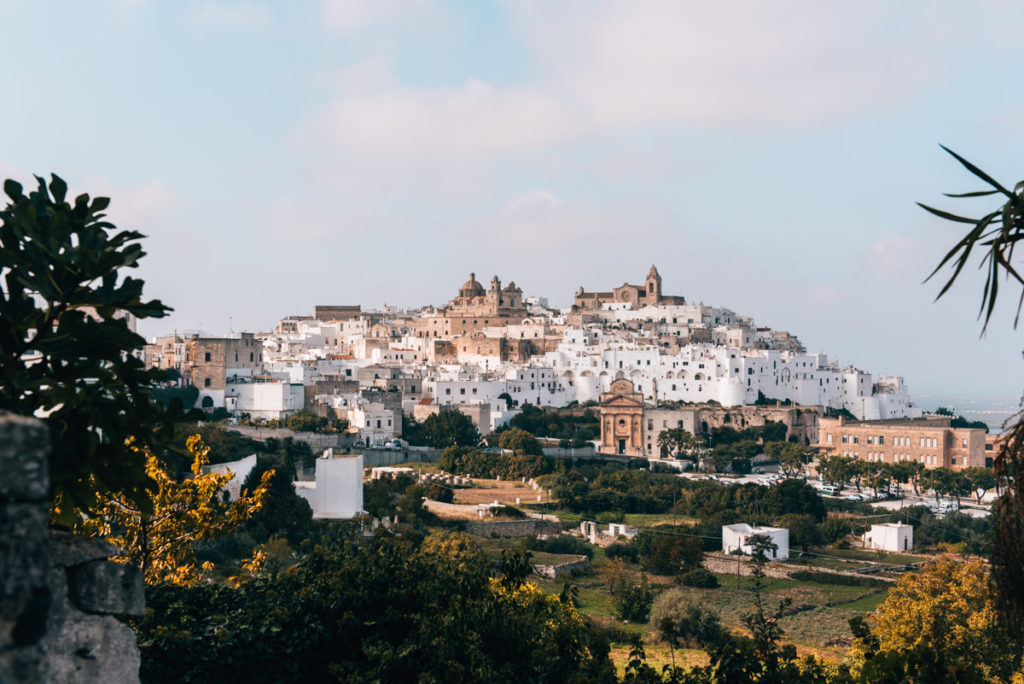Salento, the southern peninsula of Puglia, wows you with its spectacular, rugged coastline. Nestled between two seas – the Adriatic to the east and the Ionian Sea to the west – a refreshing breeze is a constant companion during a holiday in Salento.
But there’s more to it than just the stunning coastal scenery. Salento is home to some of Italy’s most beautiful cities, notably the Baroque gem Lecce and the picturesque port town of Otranto.
When you’re travelling Puglia, a stay in Salento is a must on your itinerary. In this travel guide, we’re sharing our top tips for your trip to Salento.
Inhalt


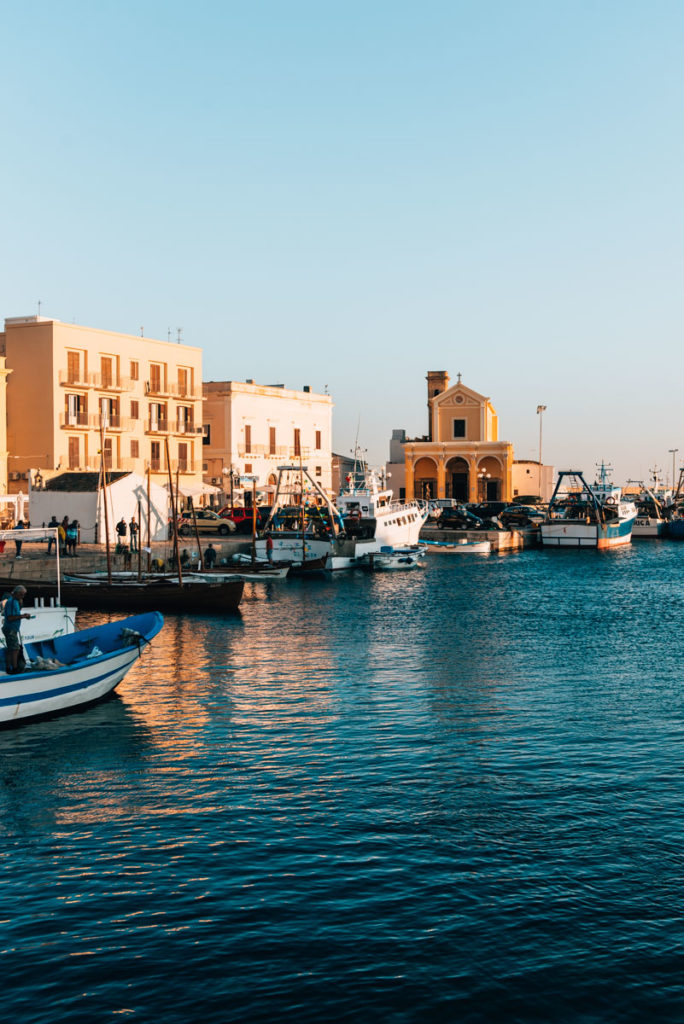
1. Salento: Quick Facts and Travel Tips at a Glance
Worthy Facts about Salento
- Salento is the peninsula forming the southernmost tip of Puglia, measuring about 100 km in length and 40 km in width.
- The nature here is largely defined by a spectacular, stunning coastline with breathtaking rock formations. The hinterland is predominantly flat.
- Salento is home to around ten million olive trees, some over a thousand years old, shaping the landscape more than any other plant. However, a sad story is that ever since 2013, a bacterium has been ravaging in the area. It is estimated to have killed about two-thirds of all olive trees something we will give you more details on shortly.
- A typical sight in Salento are the number of watchtowers along the coast, perched on headlands and cliffs. They can mainly be dated back to the 15th and 16th centuries when they were used for defence purposes.
The Sad Fate of Olive Trees in Salento
Olive groves as far as the eye can see. For centuries, Salento has been defined by its ancient olive trees, telling stories with their thick, gnarled trunks. Sounds quite romantic doesn’t it? And it would be.
Had things not taken a sad turn in 2013. A bacterium (“Xylella fastidiosa”) has been spreading, which is nearly impossible to stop. It blocks the water and nutrient transport within the tree, causing it to dehydrate and die, taking a part of Salento’s identity with it.
This means that the panorama of lush green olive trees has now been replaced with dried-up tree crowns that stick out from the landscape. Not all olive trees have fallen victim to the bacterium, but a significant number have, and it’s tough to contain the spread.
We were utterly shocked by the scale of this catastrophe, which has also become a problem in other parts of Puglia.
How Much Time Should I Allocate for Salento?
Although “only” 100 kilometres long, Salento offers an incredible amount to see. If you’re planning a road trip through all of Puglia, we’d recommend at least three days for Salento. This way, you can visit the key cities (e.g. Lecce, Otranto or Gallipoli) and explore the stunning coastline.
Prefer to take it easy? Then stay a bit longer (about 5 days) in Salento. This gives you enough time for a few relaxing days at the beach.

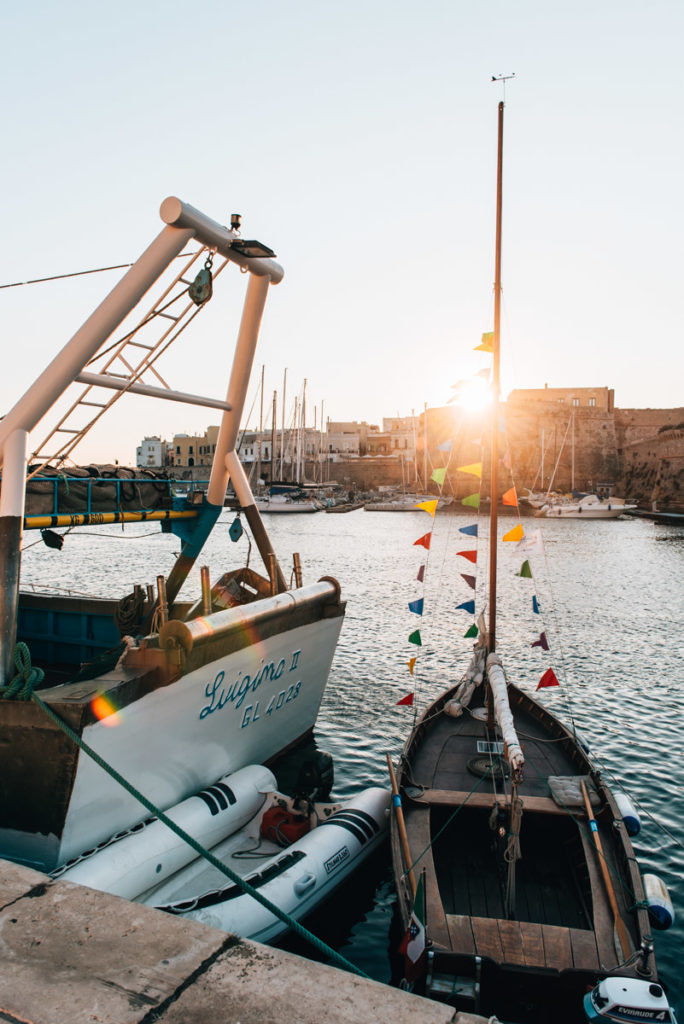
2. Staying in Salento: Our Hotel Recommendation
Tip in Advance: One or Multiple Home Bases?
Wondering whether to plan for just one or several stops in Salento? There’s no right or wrong here, and it’s all down to personal preference.
Given that distances aren’t overly long, you can reach most destinations in Salento in under an hour. Why not pick a centrally located accommodation and then venture out to explore Salento from there?
That’s what we did, and we’d choose it again in a heartbeat. Additionally, we spent a night in Lecce to fully enjoy the old town vibe of this special city in the evening. This split was the best option for us.
Our Stay in Salento: Masseria Corte degli Aromi
What a dreamy retreat! The elegant Masseria Corte degli Aromi is the perfect cosy spot for a splendid holiday in Salento.
The Masseria (an old, renovated farmhouse, similar to a Finca in Spain) is located in a picturesque green setting on the edge of the small village of Palmariggi, near Otranto. It houses just seven suites, each uniquely decorated. The stylish and elegant design runs consistently throughout the property.
As for the suite: It lacks nothing in terms of amenities. From the comfy bed to the private pool, it’s a place to completely unwind. Both the suite and the rest of the property are high-end and furnished with an eye for detail.
The breakfast is top-notch. Italians prefer sweets for breakfast, so the morning cake selection outdoes any dessert buffet. But don’t worry, there’s plenty of savoury options too, like cheese, antipasti, as well as muesli and very good bread.
Our verdict: An oasis perfectly located for exploring Salento. It’s not exactly cheap, but especially in the off-season, you can find good deals. We’d stay here again in a heartbeat.
You can book the hotel here: Masseria Corte degli Aromi
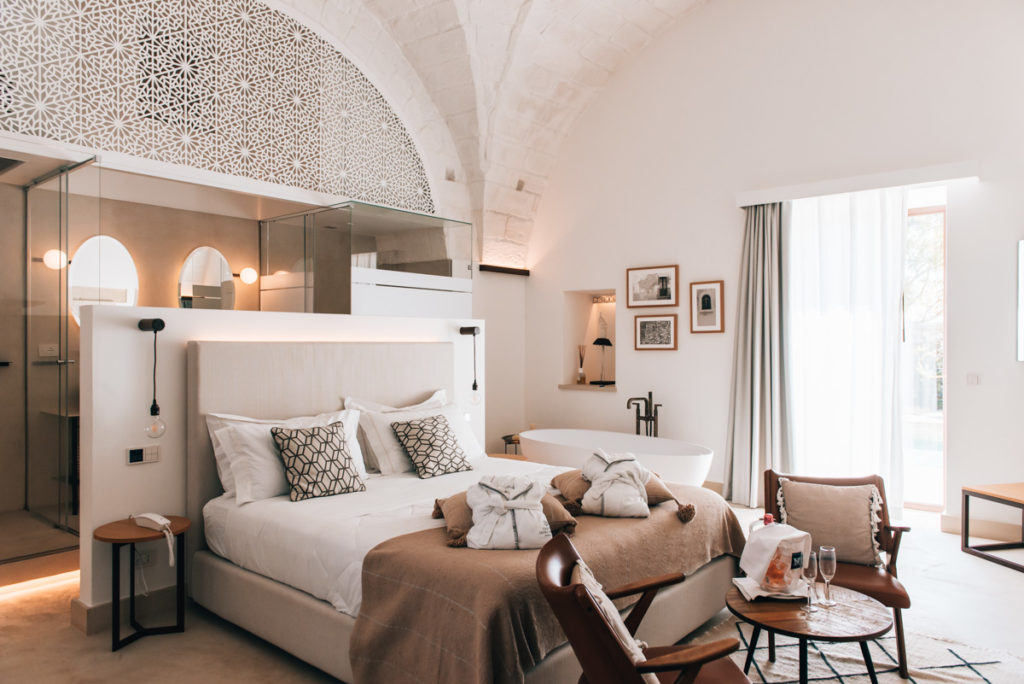
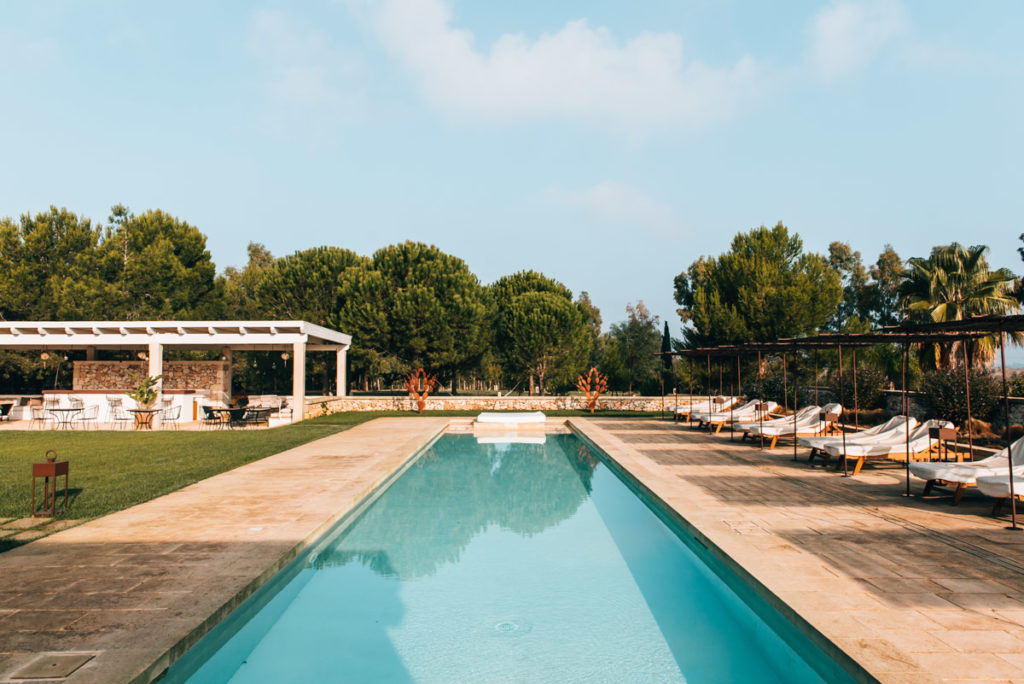
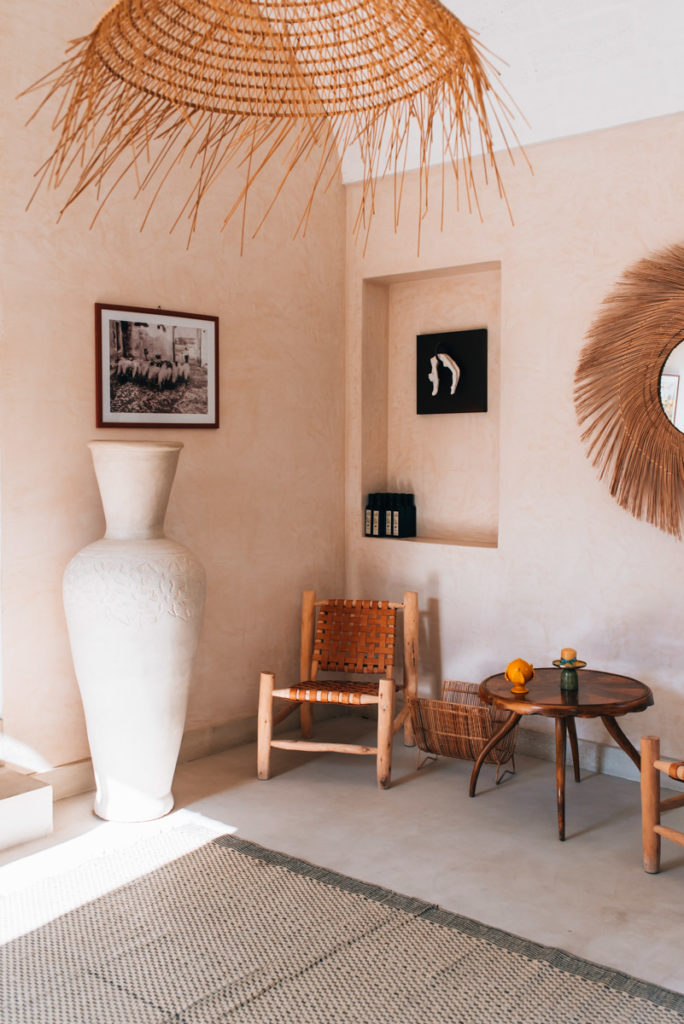

3. Salento Eastern Coastal Road Travel Guide: Attractions & Places
One of the absolute highlights in Salento is driving along the stunning coastal road in the east. The section between Otranto and Santa Maria di Leuca, at the southernmost tip of Salento, is especially famous. But there are also several worthwhile stops north of Otranto.
We suggest you set aside at least a full day for this. The total driving time along the coast is about two hours, but with photo stops and ample time for city tours, a day can fill up quickly.
In this chapter of our travel guide, we’ll introduce you to some worthwhile stops along the coastal road from north to south. Our tip: Start in the north and aim to arrive in Santa Maria di Leuca by sunset. It’s stunning there!
Grotta della Poesia
The journey starts at one of the most famous rock formations in Salento, the Grotta della Poesia. The power of the sea currents have created a beautiful natural pool formation here.
Important to note: Swimming is now prohibited in the Grotta della Poesia. However, not everyone adheres to this (as seen in the photo). Although the scenery with its turquoise waters is picturesque, we find the Grotta della Poesia somewhat overrated.
Why? Personally, the rather touristy setup (admission fee, etc.) put us off a bit. There are so many beautiful spots along Salento’s coast that are free, so we moved on quite quickly.
Admission: 3 Euros
Parking: e.g., at “Parcheggio Roca Vecchia” (paid, about 5 minutes on foot)
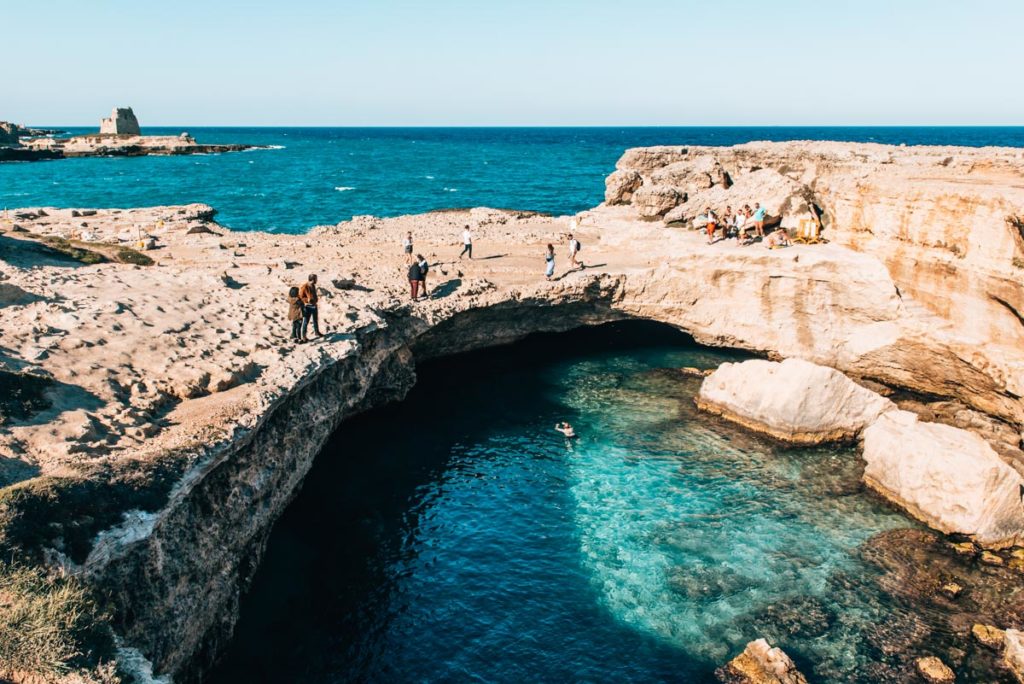
Le Due Sorelle
Just a quick ten-minute drive south from the Grotta della Poesia, you’ll reach the next rock formation: Le Due Sorelle, or “The Two Sisters” in English.
From the car park, it’s about a 5-minute walk to the cliffs, where you’ll be treated to a lovely view of the two rocks. You can walk a bit further along the cliffs, but please be cautious, as there are no safety barriers.
Overall, it’s a nice spot but nothing extraordinary. If you’re pressed for time, you could consider skipping this stop.
Parking: e.g., at “Parcheggio Belvedere” (paid, about 5 minutes on foot)
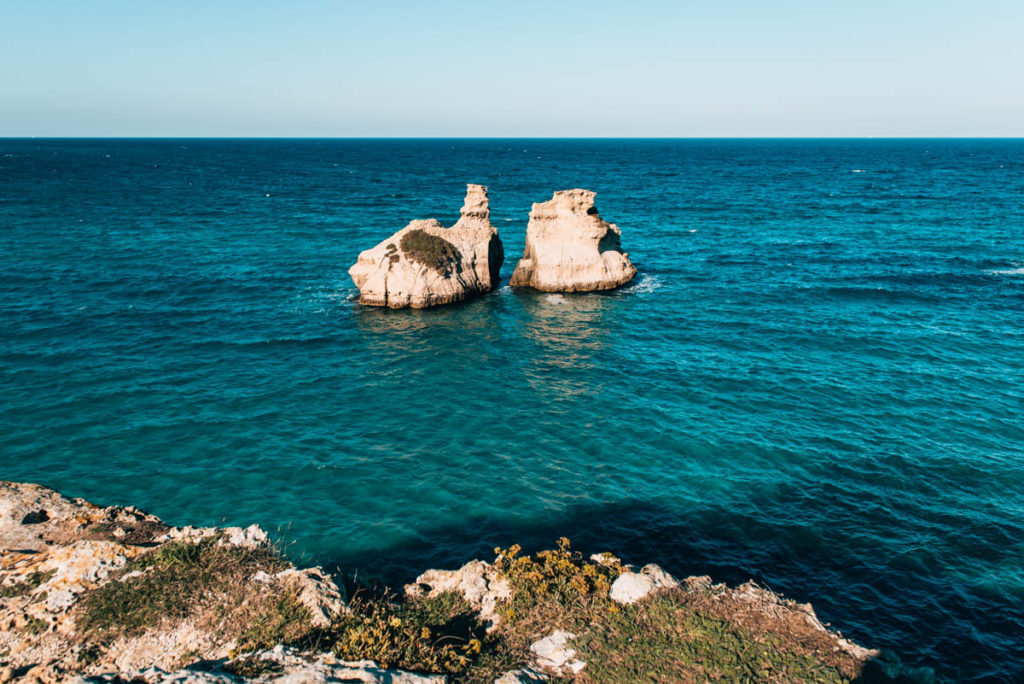
Torre Sant’Andrea
In our opinion, one of the most beautiful natural sceneries in Salento is the rock formations at Torre Sant’Andrea. Here, you’ll find a spectacular, rugged cliff landscape, which personally reminded us a bit of Australia’s Great Ocean Road.
During our off-season visit, it was fairly quiet during the day, allowing us to fully enjoy the breathtaking scenery at our leisure. When the sea is calm, you can also go swimming, as there’s a small bay. However, the current was too strong for us at the time.
We loved it so much here that we returned the next day to watch the sunrise. Watching the rocks being bathed in the first rays of sunlight was a truly magical experience! This is also a chance to have the place all to yourself during the high season.
Parking: e.g., at “Parcheggio dei Faraglioni” (paid, about 3 minutes on foot)
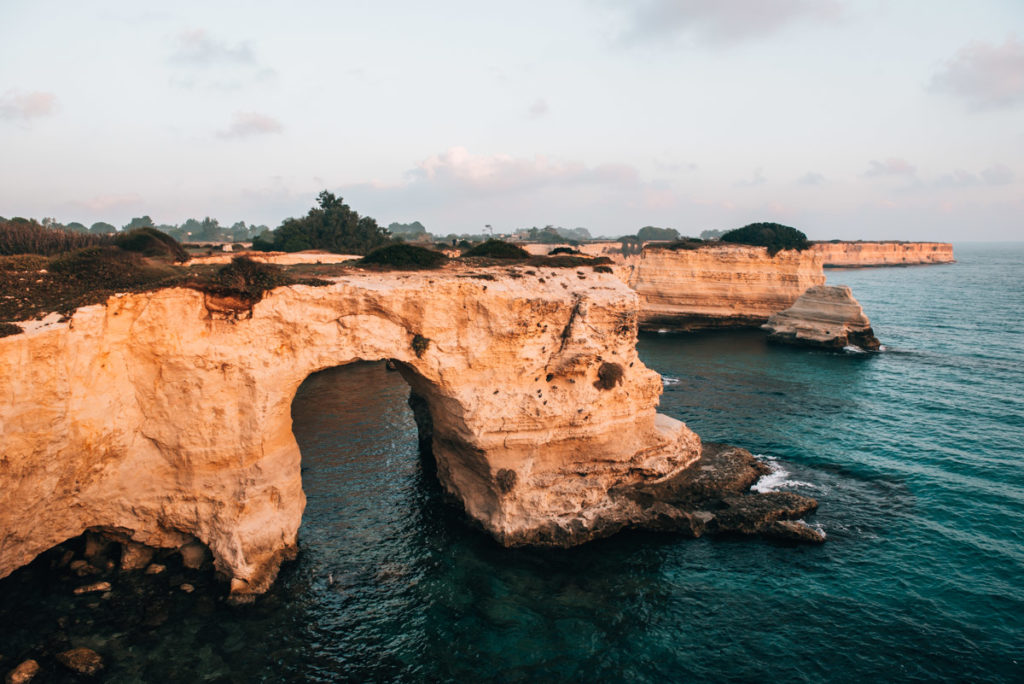
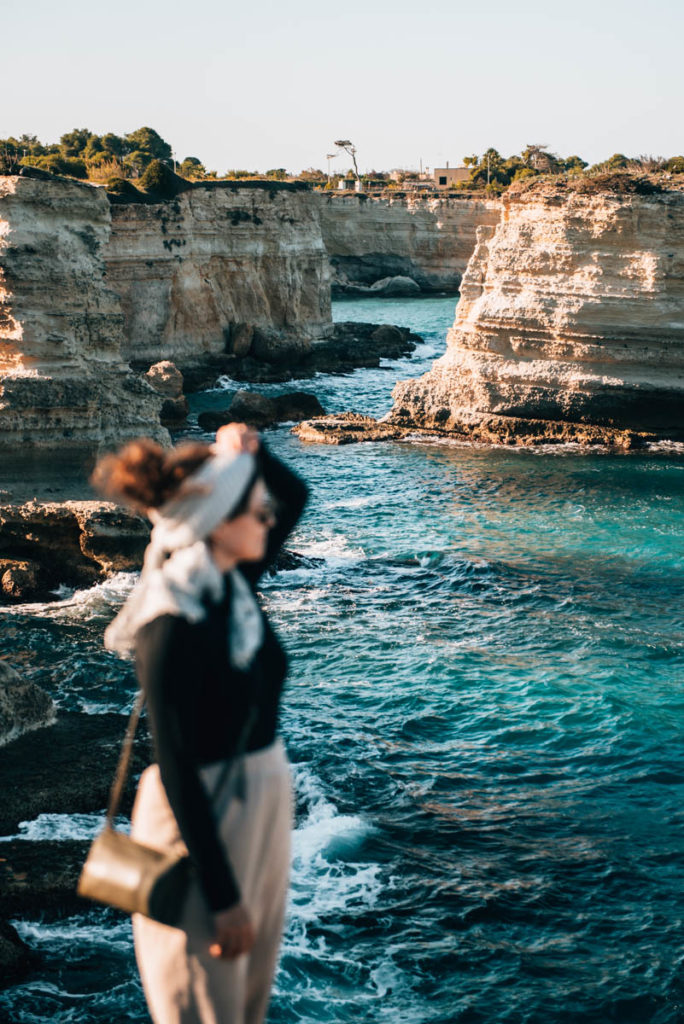
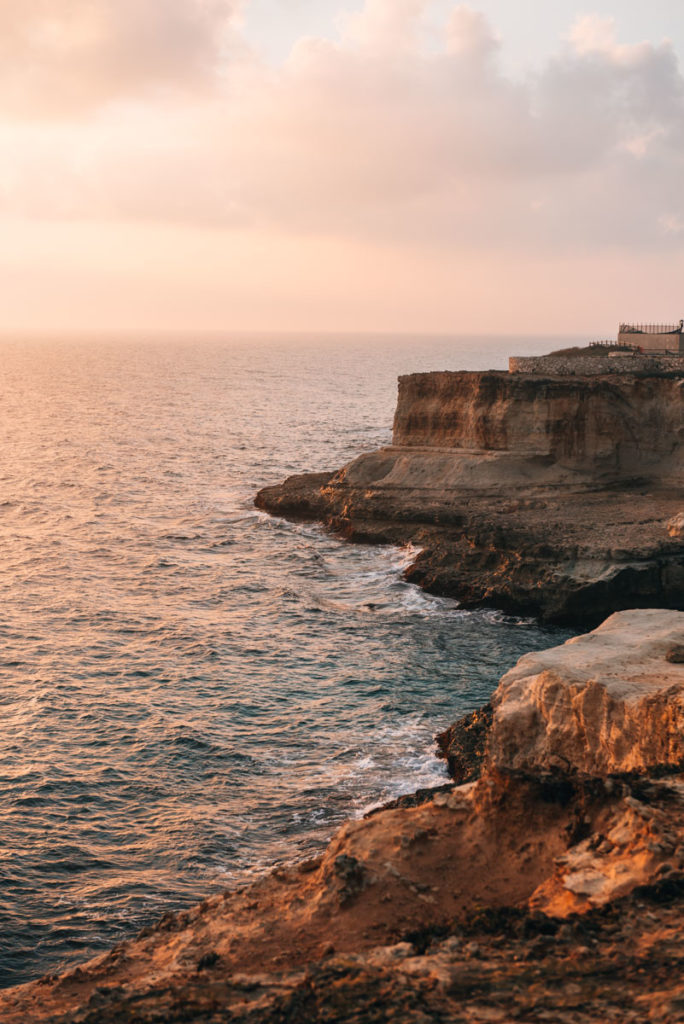
Otranto
The next stop is the gorgeous port city of Otranto. We recommend setting aside at least an hour for this visit. We’ll share our tips and the most beautiful attractions in the next chapter, titled “Must-Visit Cities in Salento.”
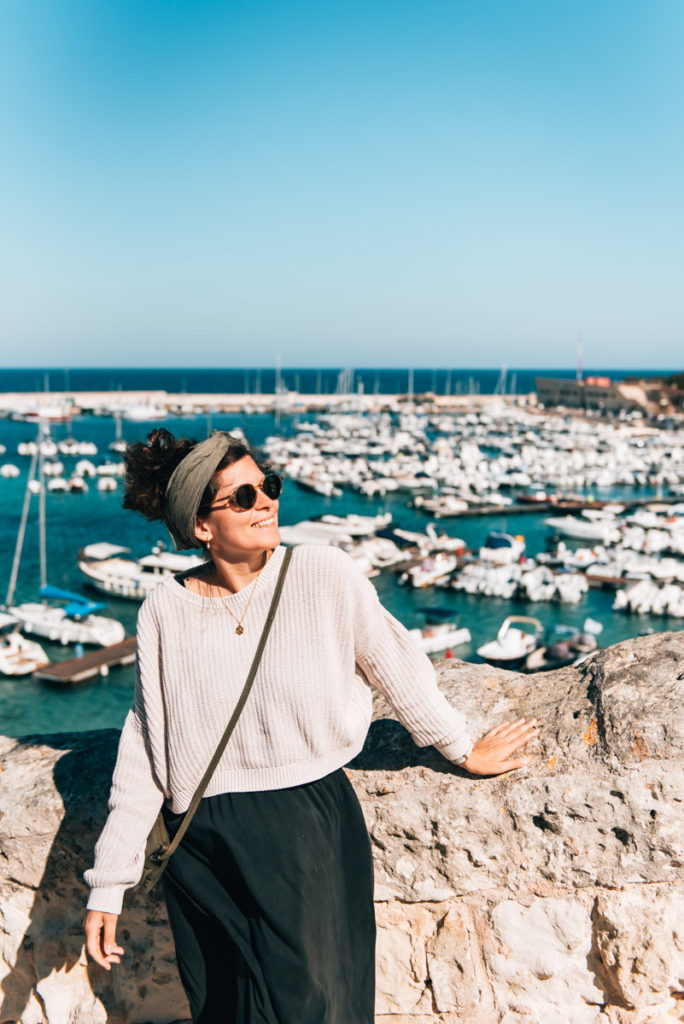
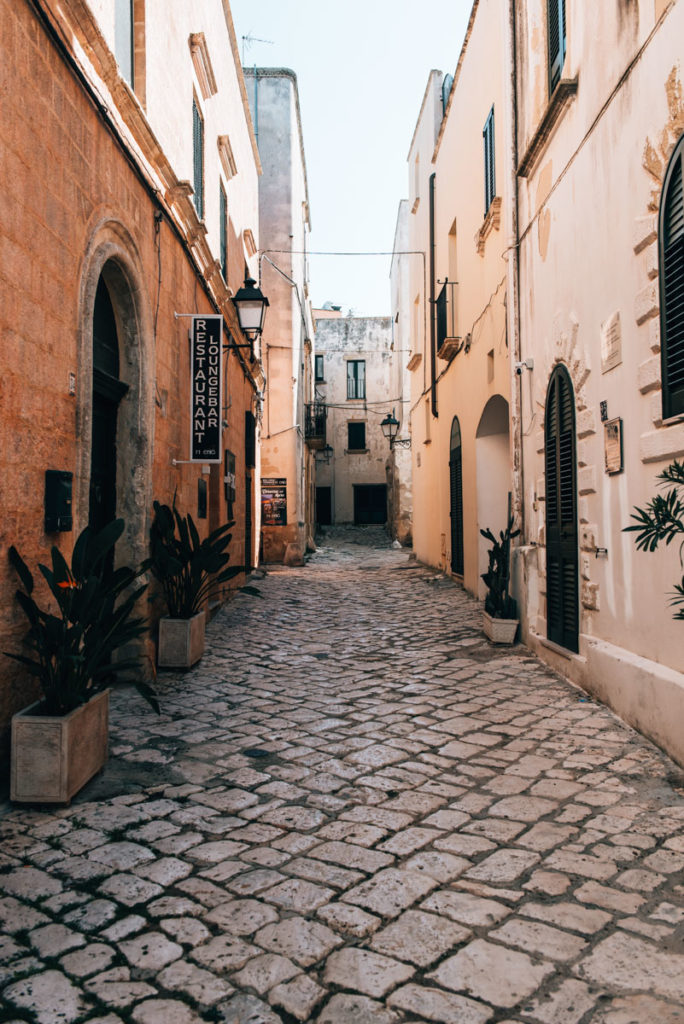
Lighthouse near Otranto
Just about a ten-minute drive south of Otranto, you’ll find your next stop worth considering. Here, at Italy’s easternmost point, stands the Punta Palascìa lighthouse.
From the parking area, which is quite small and easy to miss, a gravel path (about a 10-15 minute walk) leads down to the lighthouse. On a clear day, you can even spot the mountains of Albania on the horizon.
Parking: At the unpaved parking area on the road near the small military building (free of charge)
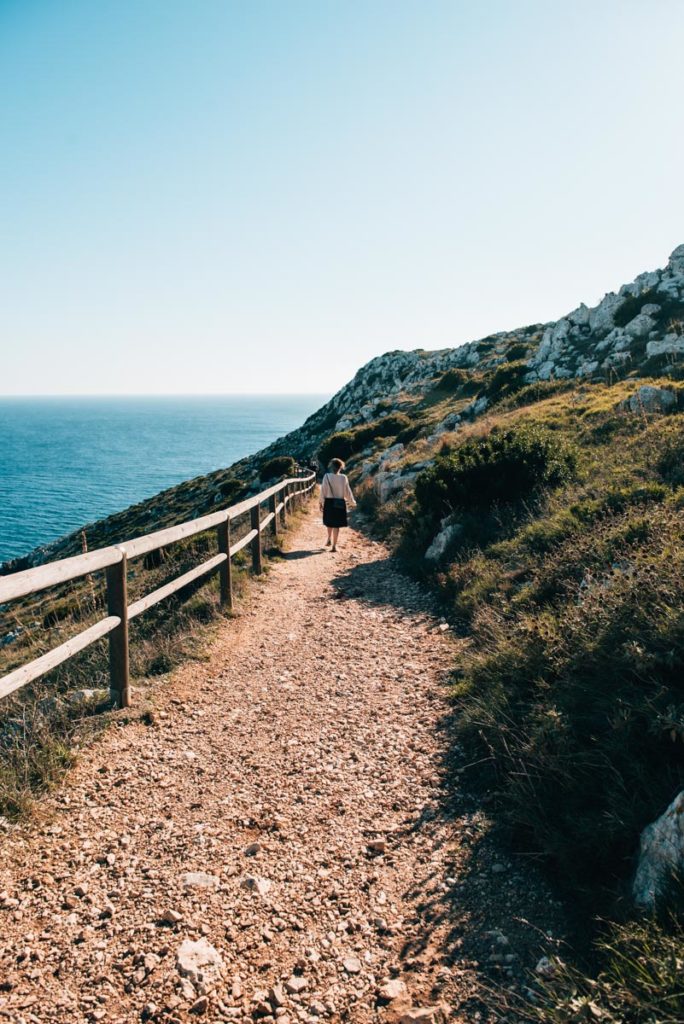
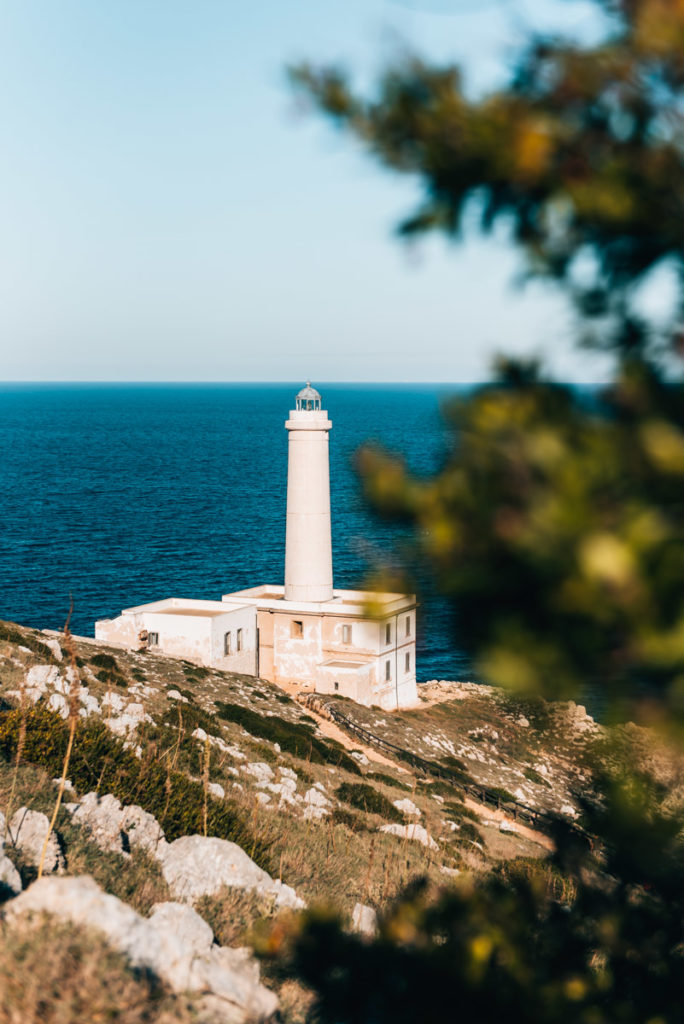
Santa Cesarea Terme
Moving southward, our next stop is Santa Cesarea Terme, a charming, rather upscale spa town famous for its spa and wellness facilities. Since ancient times, Santa Cesarea Terme has been home to several caves with sulphurous healing water.
The town’s unofficial landmark is Palazzo Sticchi, a striking palace in Moorish style. Currently (as of Autumn 2022), the palace is under renovation and is scaffolded.
If you’re keen on a swimming break in Santa Cesarea Terme, the Spiaggia Porto Miggiano offers a lovely bay. The path down is a bit of an adventure and is definitely not suitable for the elderly, frail, or small children.
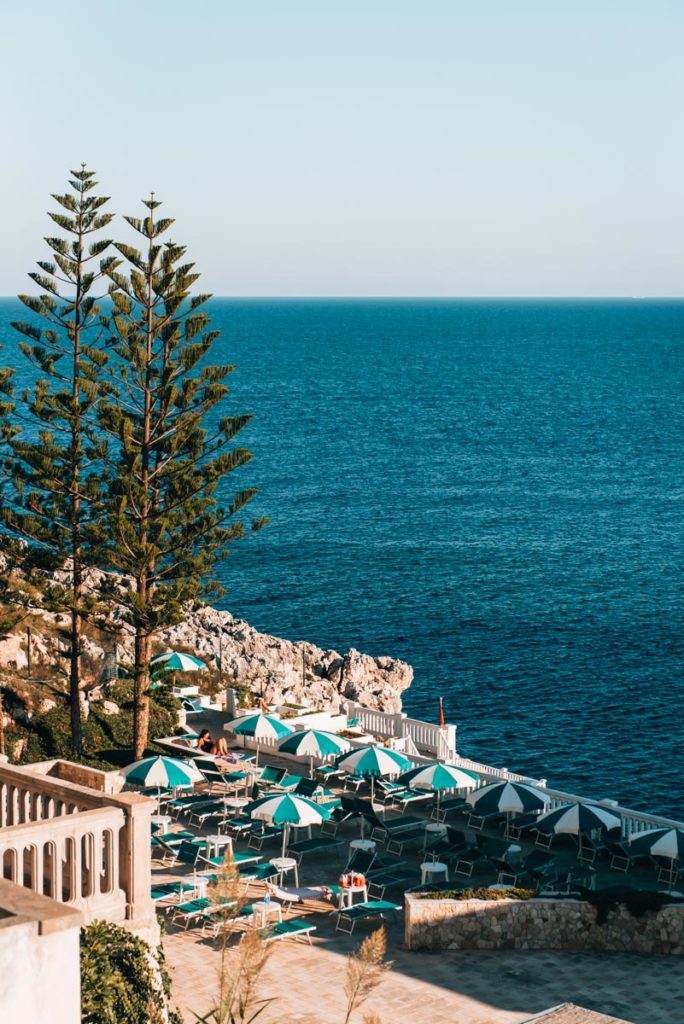

Ponte Ciolo
We made a spontaneous stop here, prompted by the sight of several parked cars and quite a few young people – a twist of fate! From the car, you can’t quite grasp the impressive surroundings you’re in.
About 26 meters high, the “Ponte Ciolo” bridge connects the two sides of a spectacular gorge. Below, there’s a stunning swimming cove. The view alone from the bridge down into the gorge is worth a brief stop.
If you have more time, you can of course hike down. We suspect it gets pretty busy here in high season. During the off-season, it was pleasantly quiet.
Parking: Depending on availability, along the road south of the bridge. (However, it can get tricky when it’s busy.)
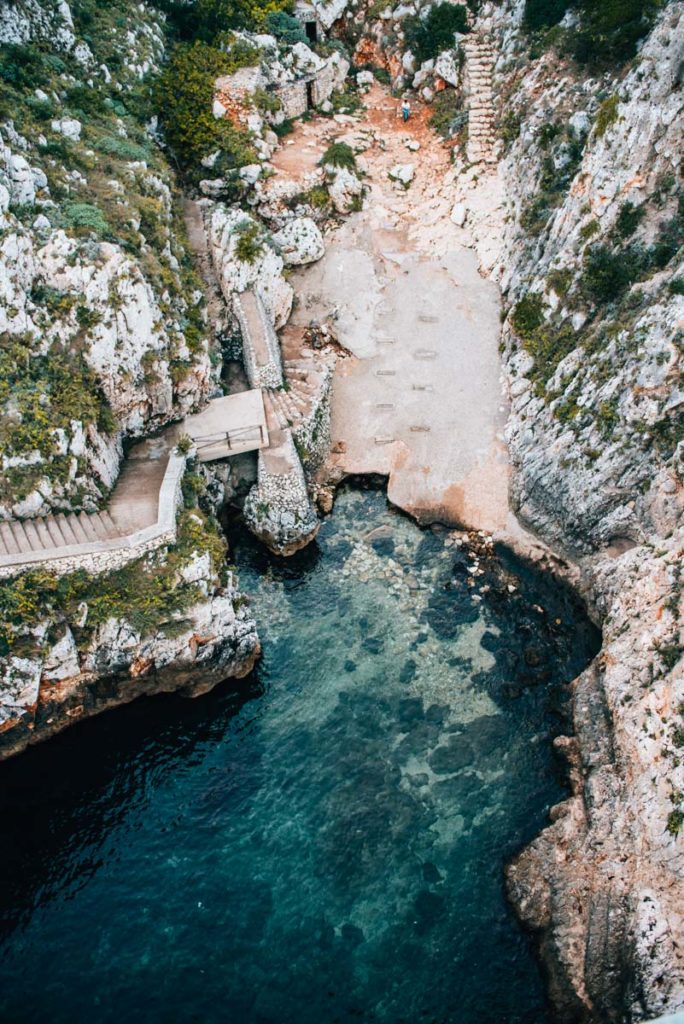
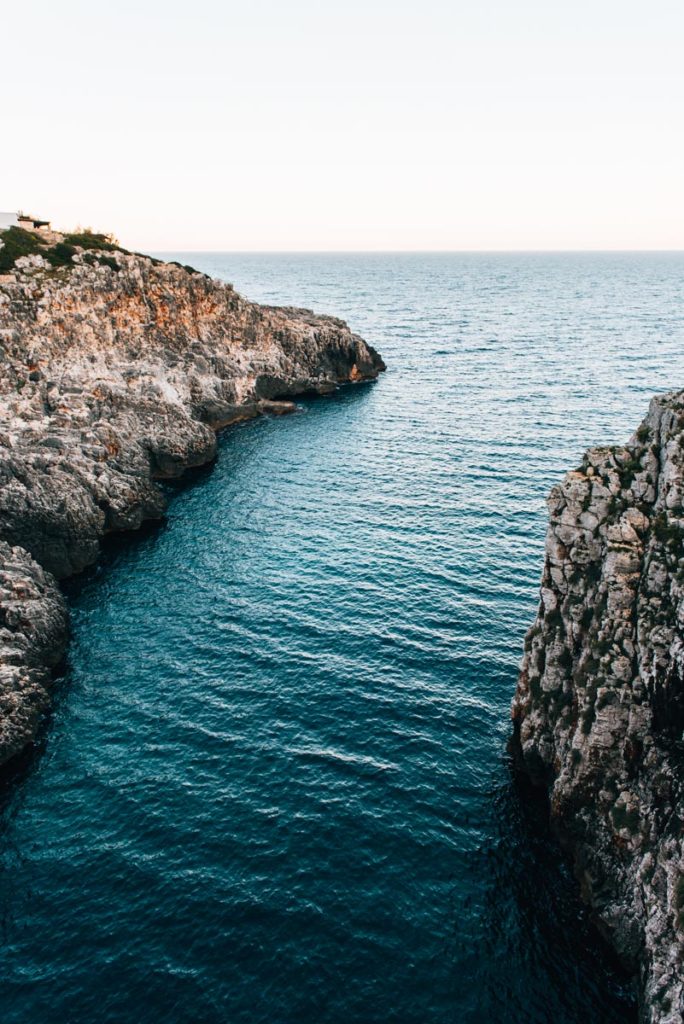
Santa Maria di Leuca
Last but not least, the final stop on our mini road trip along the east coast of Salento: Santa Maria di Leuca. This southernmost point of Puglia is the perfect spot to enjoy a sunset. We’ll share our tips for this in the next chapter titled “Must-Visit Cities in Salento.”
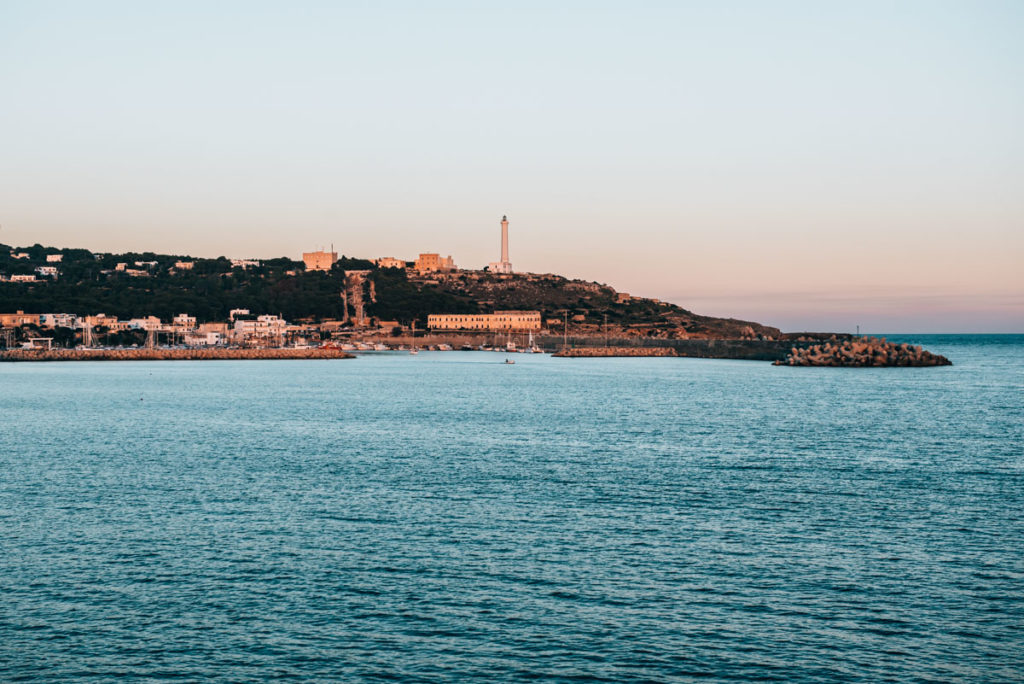
4. Must-Visit Cities in Salento
Lecce
Lecce, the largest and one of the most significant cities in Salento, is renowned for its Baroque architecture. The city is home to some of the most important attractions in Salento, with its numerous impressive Baroque buildings.
Firstly, there are the many monumental churches of Lecce, notably the gigantic cathedral. It dominates the massive Piazza del Duomo. We were particularly amazed by the crypt beneath the cathedral – wow!
Equally impressive is the Roman Amphitheater at Piazza Sant’Oronzo. Dating back to the 2nd century, it was actually discovered accidentally during excavations in the early 20th century.
We’d suggest allocating half a day for Lecce to see the main attractions. Ideally, you should stay overnight to fully enjoy the great ambiance in the evening.
You can find our detailed travel guide here: Lecce Travel Guide
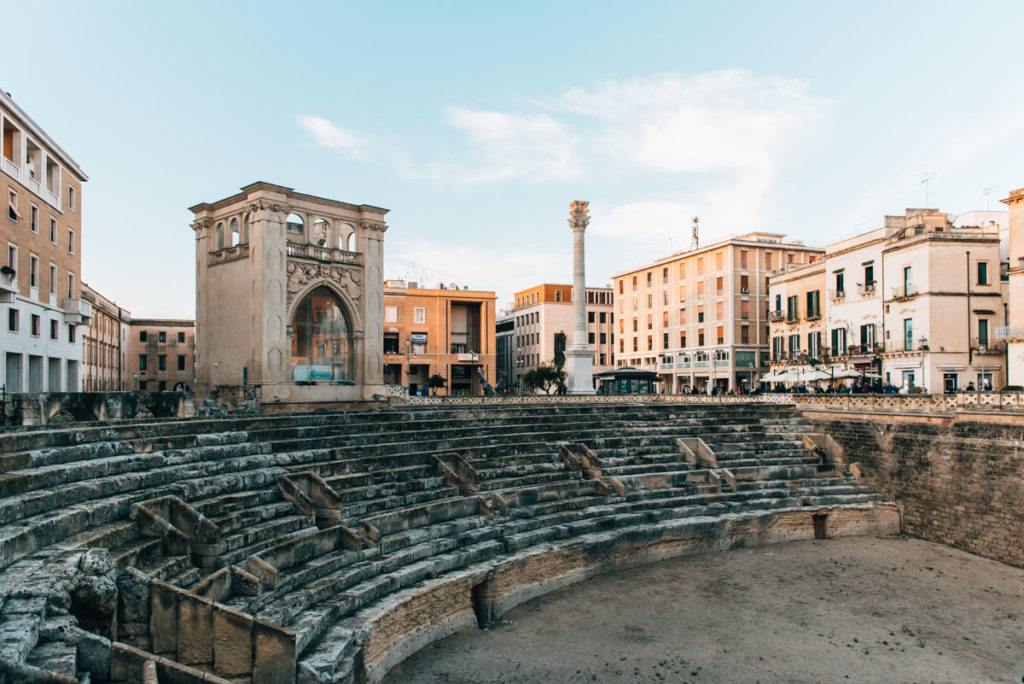
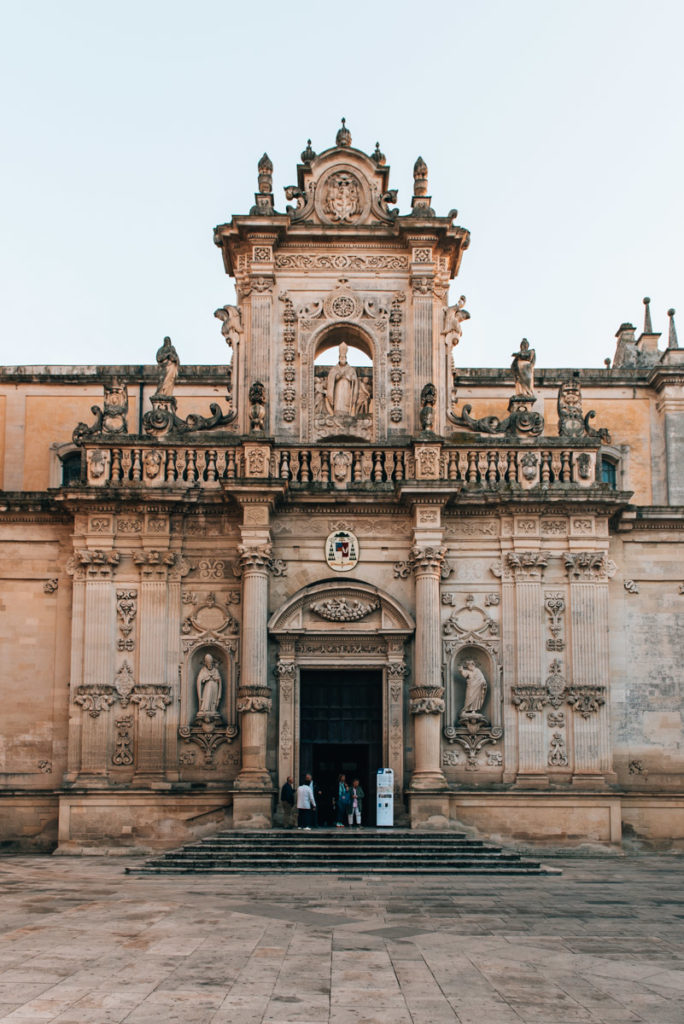
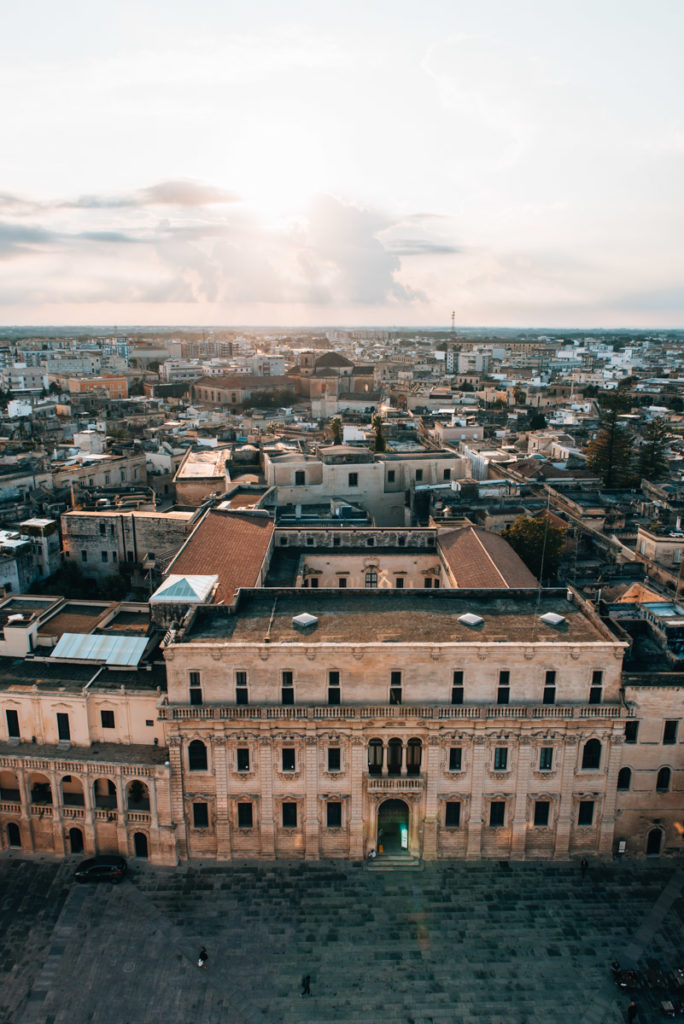
Otranto
Otranto rightfully ranks among the “borghi più belli d’Italia”, the most beautiful places in Italy. The cosy vibe of the small port town with its white coloured houses immediately appealed to us.
The old town of Otranto, with its maze of narrow alleys, is a little gem in Salento – though quite touristy. This becomes evident when you notice the lack of local food vendors or everyday shops in the old town.
We recommend setting aside about two hours for your stroll through Otranto. Here are some places and attractions we suggest:
- Basilica Cattedrale di Santa Maria Annunziata: The cathedral of Otranto and the city’s most important sight. It’s especially famous for its 12th-century floor mosaic. (Little tip: Keep in mind the cathedral’s lunch break hours!)
- Castello di Otranto: This old fortress dates back to the 10th century. It houses a museum inside, though we admittedly only admired it only from the outside.
- Lungomare: The palm-lined seafront promenade of Otranto is also worth a visit. It’s best to walk from the old town to the city beach – from there, you’ll have a nice view back towards Otranto.
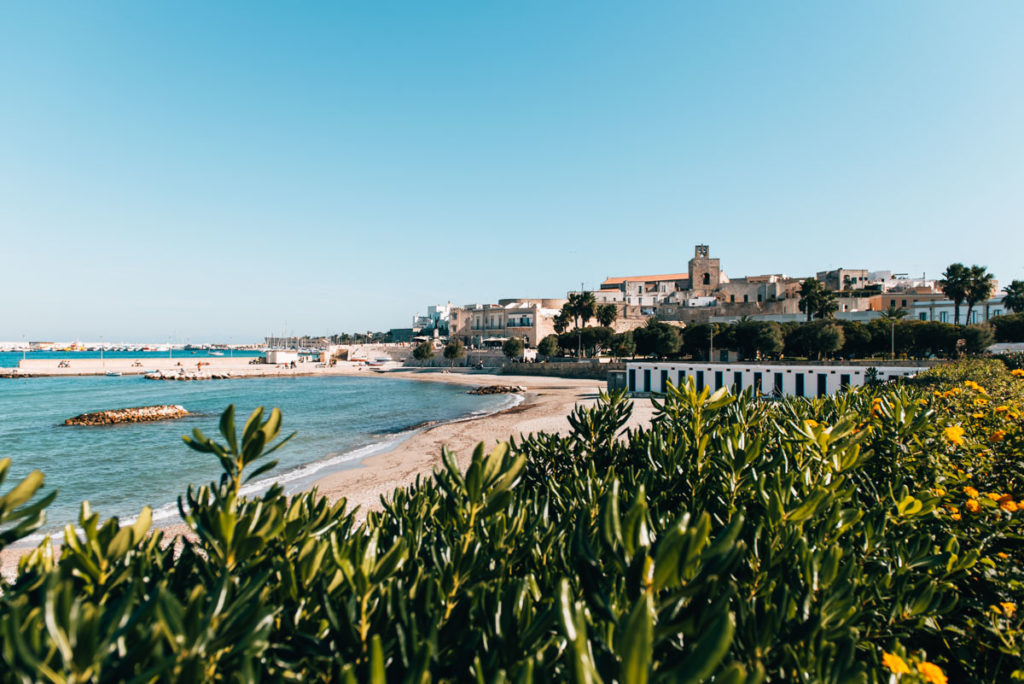

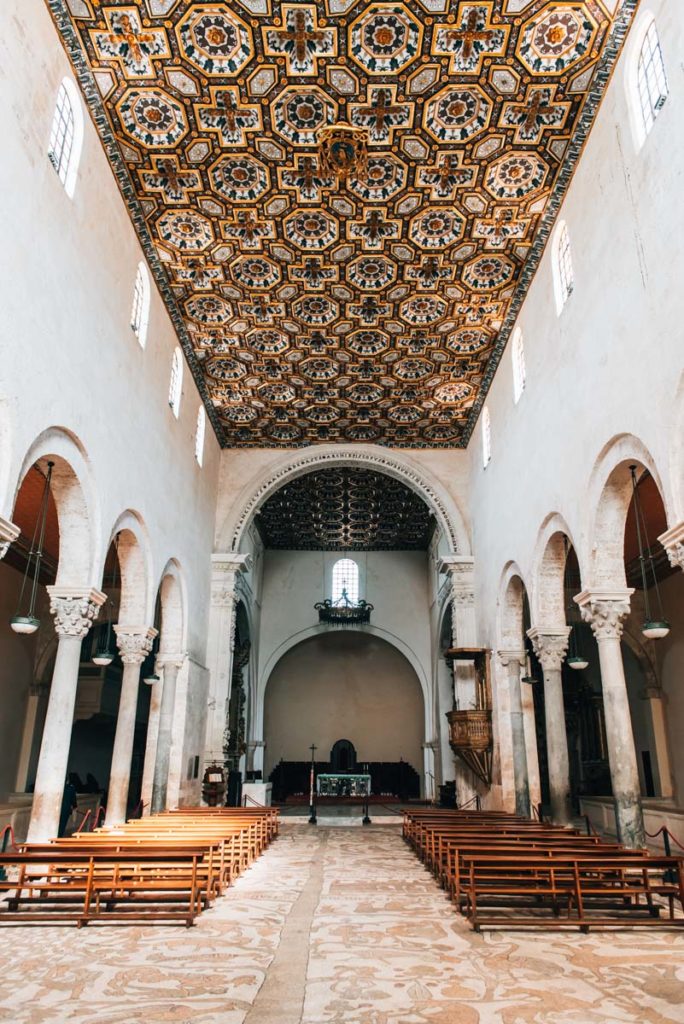
Gallipoli
The quaint port town of Gallipoli is also a must-visit. Located on the west coast of Salento, it’s an ideal spot for enjoying a sunset.
The city’s Greek origin is no coincidence – Gallipoli was founded by the Greeks. The old town of Gallipoli sits picturesquely on a rocky island, connected to the mainland by a bridge.
You’ll find a labyrinth of narrow alleys – quite beautiful, but also quite touristy. Fortunately, the crowds are more manageable in the off-season.
We recommend setting aside about two hours for a visit. Don’t miss the following places and attractions:
- Castello di Gallipoli: This historic fortress stands prominently at the bridge at the entrance to the old town. Here, you’ll also find the old fishing harbour.
- Basilica Cattedrale di Sant’Agata: The cathedral of Gallipoli is currently under renovation (as of Autumn 2022).
- Spiaggia della Purità: The city beach and the best spot for watching the sunset.
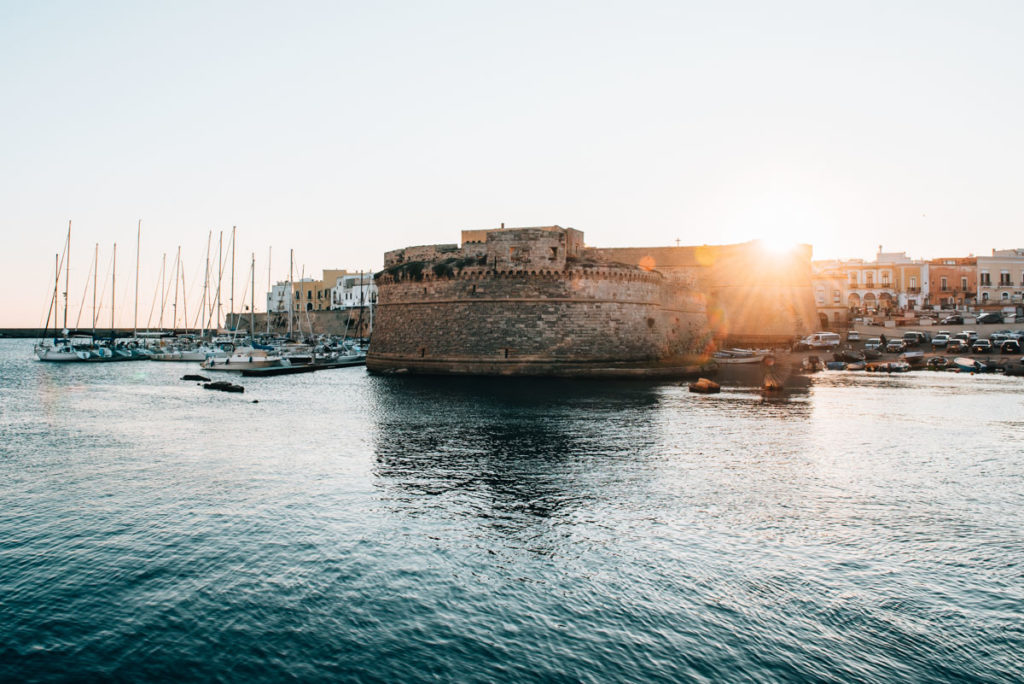
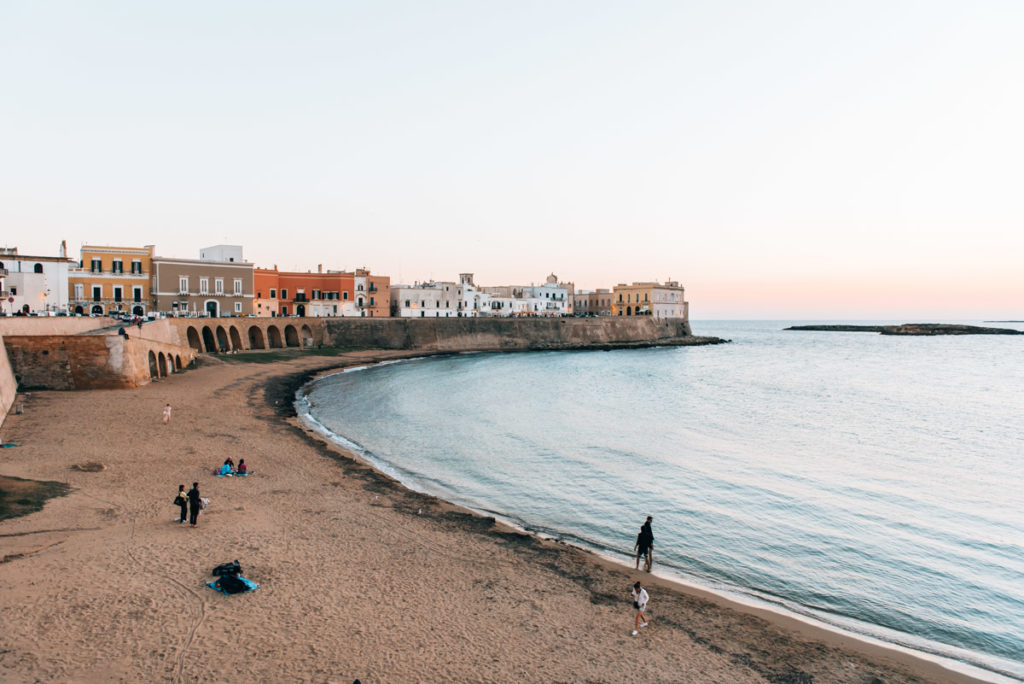

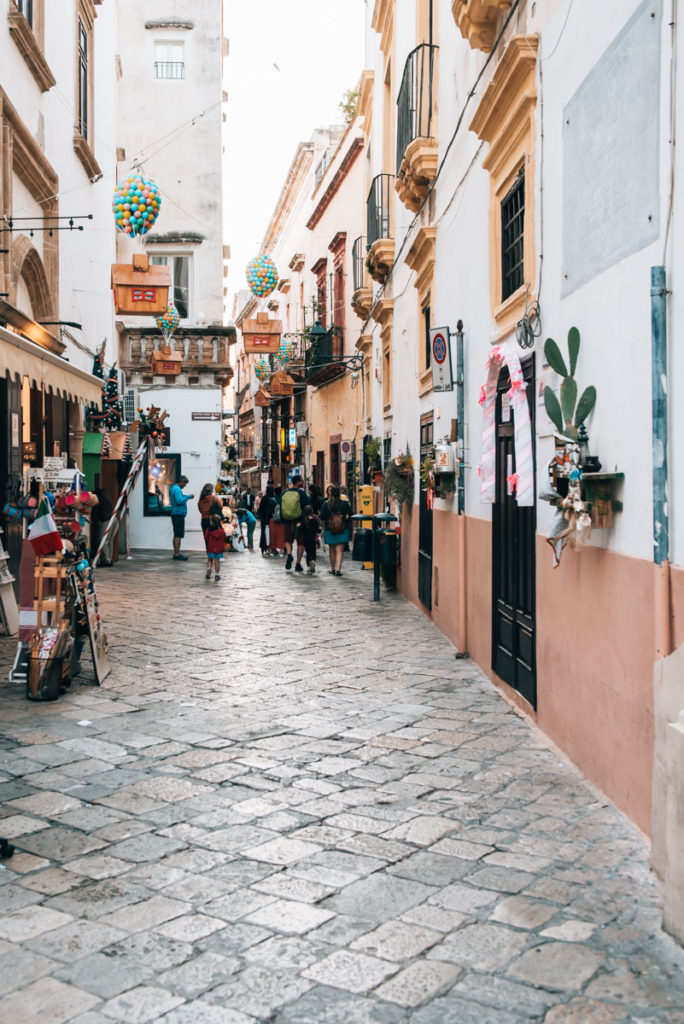
Santa Maria di Leuca
At the southernmost point of Puglia lies the small coastal town of Santa Maria di Leuca, where the Adriatic meets the Ionian Sea. We were there before sunset and highly recommend this time of day.
One of the most famous attractions is the Santuario di Santa Maria de Finibus Terrae. It’s not so much the church itself that makes this place special, but rather the expansive, impressive square, from which you can enjoy a beautiful view down towards the harbour. There’s also a lighthouse here – overall, definitely worth a visit.
Even in the off-season, this spot can get busy before sunset. With a bit of luck, you might find a parking spot right in front.
The most incredible place for sunset viewing is about a 10-minute drive away at Cape Punta Ristola. Here, you are truly at the southernmost point of Puglia. The cape’s exposed location offers spectacular views in both directions – towards Santa Maria di Leuca and towards the sunset.
You can park quite easily right at the cape (though a bit of parking luck is needed). If you’re good on foot, you can venture out on a little walk a bit further along the cliffs.
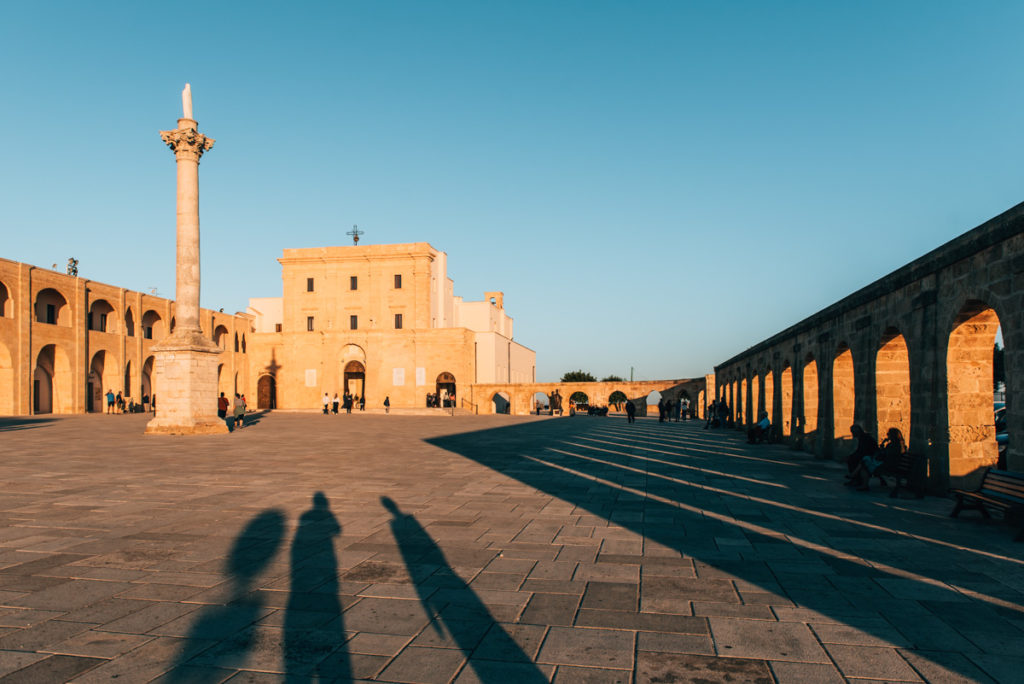
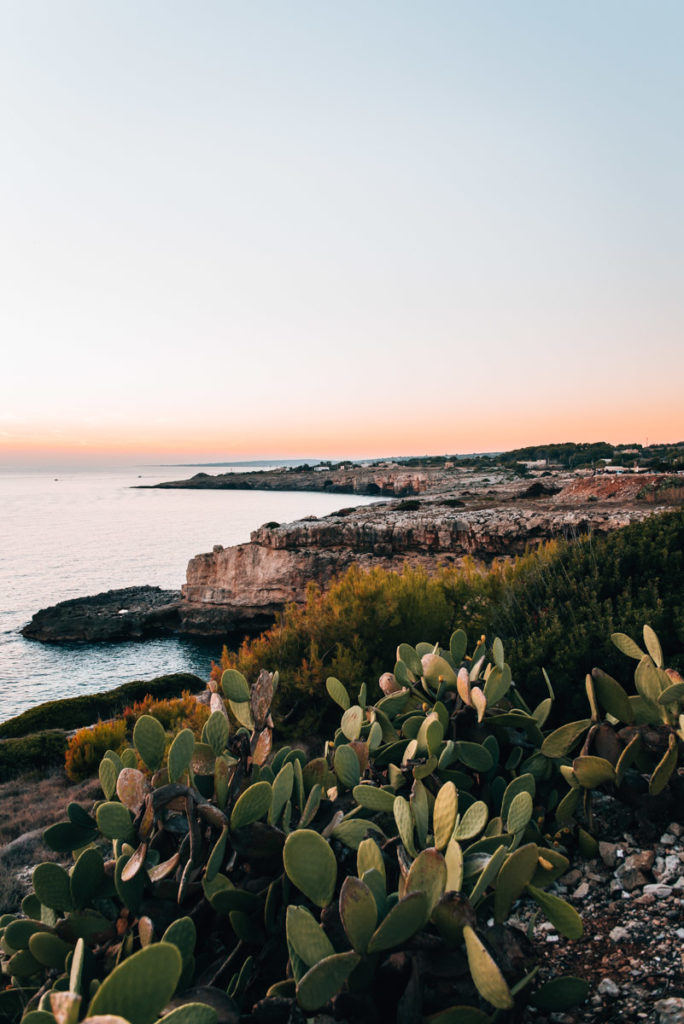
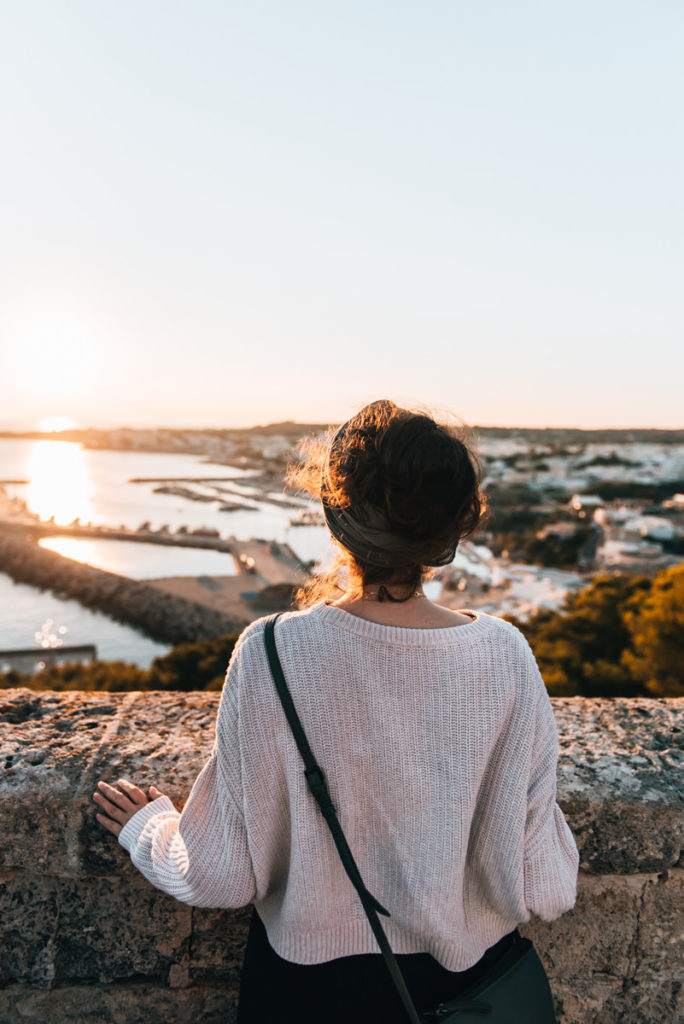
5. Beaches and Bays in Salento
Along the rugged coast of Salento, there are countless swimming coves and beaches – many tiny and hidden, others wider and more elongated. The bays on the east coast tend to be rocky. If you’re looking for sandy beaches, you’ll find them more on the west coast.
Important Note: In high season, many of the beaches in Salento are packed to the last centimetre. Puglia is a hugely popular destination among Italian tourists as well. To avoid the crowds, it’s better to visit in September.
Tips for Beautiful Beaches in Salento
Torre Sant’Andrea: This rocky cove is located right on the cliffs of the spectacular east coast of Salento. It gets crowded in summer, but the scenery is truly unique.
Baia dei Turchi: A relatively spacious sandy beach with rocky sections. Finding a parking spot in high season can be challenging. For 5 euros, you can park at “Parcheggio Baia dei Turchi Tenuta Schito”. From there, a short walk through a pine forest separates you from the beach.
Spiaggia di Pescoluse: Known as the “Maldives of Salento”, this nickname might be a bit exaggerated, but you can look forward to a very beautiful, fine sandy beach. However, it also gets quite busy in high season.

6. Map: All Locations and Tips of our Travel Guide at a Glance
Want to get a better overview of the locations of the various places in Salento? On this map, you’ll find all the places and spots we’ve mentioned marked. Small tip: For the best experience, click on the rectangle at the top right to save the map to your smartphone (Google Maps app).
Disclaimer: Affiliate Links
This travel guide contains our personal recommendations in the form of affiliate links. Which means if you book or purchase something via these links, you still pay the same (nothing changes for you) — while we receive a small commission for sharing! So it really means a lot to us and we want to say a massive thank you from us both!
Have you ever been to Salento? What attractions, places, or beaches would you recommend? We’d love to hear from you in the comments below this travel guide!
